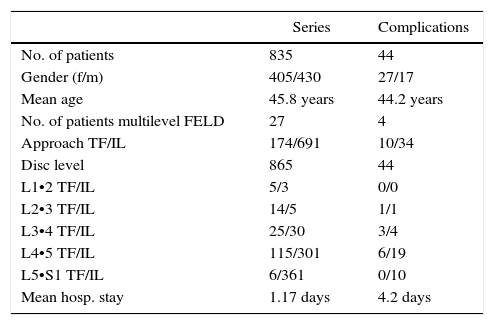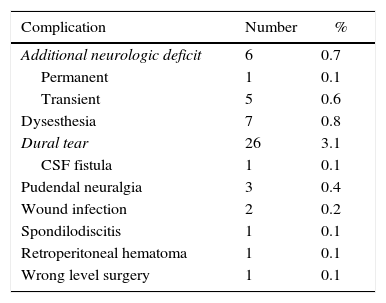To report perioperative complications in fully endoscopic lumbar discectomy (FELD).
MethodsFrom September 2010 to November 2016, 835 patients underwent FELD. In total, 865 disc levels were operated on. Of the 835 patients, the transforaminal (TF) approach was used in 174 patients, while 691 patients were operated on using the interlaminar (IL) approach. Surgical complications occurred in 47 patients, which were retrospectively analyzed.
ResultsNeurological deficits occurred in six patients. In four of these six patients, deficits resolved spontaneously. In one patient, symptoms resolved after a laminectomy procedure. In only one case, the neurological deficit was permanent. Seven patients complained of dysesthesia, which resolved spontaneously with medical treatment in four patients. In the remaining two patients, dysesthesia symptoms improved after epidural and foraminal injections. Dural tears were encountered in 26 patients. Pudendal neuralgia occurred in three patients. Two cases showed wound infection. The other complications comprised one disc infection, one retroperitoneal hematoma and one wrong level surgery.
ConclusionThe FELD procedure has a steep learning curve and it is a difficult procedure to master. Surgeons should be aware of complications that can occur with the FELD procedure, most of which resolve spontaneously.
Informar las complicaciones perioperatorias en la discectomía lumbar completamente endoscópica (FELD).
Mèc)todosDe septiembre del 2010 a noviembre del 2016, 835 pacientes fueron sometidos a FELD. Se utilizó un total de 865 niveles de disco. De los 835 pacientes, 174 pacientes fueron operados utilizando el enfoque transforaminal (TF) y 691 pacientes fueron operados en el mèc)todo interlaminar (IL). Las complicaciones quirúrgicas ocurrieron en 47 pacientes que fueron analizados retrospectivamente.
ResultadosSe presentaron dèc)ficits neurológicos en seis pacientes. En 4 de 6 de estos pacientes los dèc)ficits se resolvieron espontáneamente. En un paciente, los síntomas se resolvieron despuèc)s de un procedimiento de laminectomía. En un solo caso, el dèc)ficit neurológico fue permanente. Siete pacientes se quejaron de la disestesia, que se resolvió espontáneamente con la terapia mèc)dica en 4 pacientes. En los 2 pacientes restantes, los síntomas de la disestesia mejoraron despuèc)s de las inyecciones epidurales y foraminales. Se encontraron lágrimas dural en 26 pacientes. La neuralgia de Pudendal ocurrió en 3 pacientes. Dos casos mostraron infección de la herida. Una infección a nivel de disco, un hematoma retroperitoneal y una cirugía de nivel incorrecto fueron las otras complicaciones.
ConclusiónEl procedimiento FELD tiene una curva de aprendizaje abrupta y es un procedimiento difícil de dominar. Los cirujanos deben ser conscientes de las complicaciones que pueden ocurrir con el procedimiento FELD, la mayoría de los cuales se resuelven espontáneamente.
Article

If it is the first time you have accessed you can obtain your credentials by contacting Elsevier Spain in suscripciones@elsevier.com or by calling our Customer Service at902 88 87 40 if you are calling from Spain or at +34 932 418 800 (from 9 to 18h., GMT + 1) if you are calling outside of Spain.
If you already have your login data, please click here .
If you have forgotten your password you can you can recover it by clicking here and selecting the option ¿I have forgotten my password¿.













